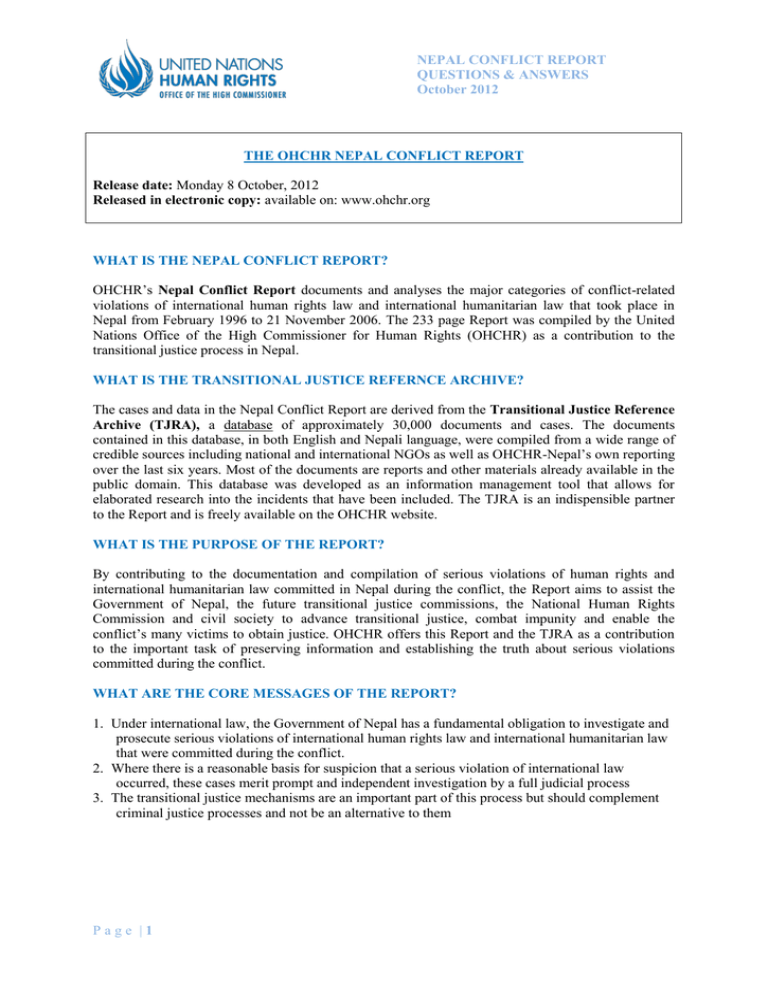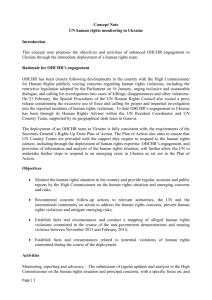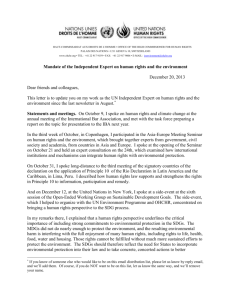
NEPAL CONFLICT REPORT
QUESTIONS & ANSWERS
October 2012
THE OHCHR NEPAL CONFLICT REPORT
Release date: Monday 8 October, 2012
Released in electronic copy: available on: www.ohchr.org
WHAT IS THE NEPAL CONFLICT REPORT?
OHCHR’s Nepal Conflict Report documents and analyses the major categories of conflict-related
violations of international human rights law and international humanitarian law that took place in
Nepal from February 1996 to 21 November 2006. The 233 page Report was compiled by the United
Nations Office of the High Commissioner for Human Rights (OHCHR) as a contribution to the
transitional justice process in Nepal.
WHAT IS THE TRANSITIONAL JUSTICE REFERNCE ARCHIVE?
The cases and data in the Nepal Conflict Report are derived from the Transitional Justice Reference
Archive (TJRA), a database of approximately 30,000 documents and cases. The documents
contained in this database, in both English and Nepali language, were compiled from a wide range of
credible sources including national and international NGOs as well as OHCHR-Nepal’s own reporting
over the last six years. Most of the documents are reports and other materials already available in the
public domain. This database was developed as an information management tool that allows for
elaborated research into the incidents that have been included. The TJRA is an indispensible partner
to the Report and is freely available on the OHCHR website.
WHAT IS THE PURPOSE OF THE REPORT?
By contributing to the documentation and compilation of serious violations of human rights and
international humanitarian law committed in Nepal during the conflict, the Report aims to assist the
Government of Nepal, the future transitional justice commissions, the National Human Rights
Commission and civil society to advance transitional justice, combat impunity and enable the
conflict’s many victims to obtain justice. OHCHR offers this Report and the TJRA as a contribution
to the important task of preserving information and establishing the truth about serious violations
committed during the conflict.
WHAT ARE THE CORE MESSAGES OF THE REPORT?
1. Under international law, the Government of Nepal has a fundamental obligation to investigate and
prosecute serious violations of international human rights law and international humanitarian law
that were committed during the conflict.
2. Where there is a reasonable basis for suspicion that a serious violation of international law
occurred, these cases merit prompt and independent investigation by a full judicial process
3. The transitional justice mechanisms are an important part of this process but should complement
criminal justice processes and not be an alternative to them
Page |1
NEPAL CONFLICT REPORT
QUESTIONS & ANSWERS
October 2012
WHICH CRIMES ARE EXAMINED IN THE REPORT?
The Report focuses on the most serious categories of violations observed during the conflict: unlawful
killings, disappearances, arbitrary arrest, torture and sexual violence. It also examines obstacles to
victims obtaining an effective remedy.
ARE PERPETRATORS AND VICTIMS NAMED IN THE REPORT?
Cases of alleged violations are discussed in the Report to illustrate the application of international
law. The names of perpetrators and victims are not stated in the Report or the TJRA unless this
information has already been disclosed in publicly available documents. The Report is not intended to
make judgements about individual cases or to declare individuals guilty. The Report is intended to
show that were there is a credible allegation that amounts to a reasonable basis for suspicion that a
serious violation of international law has occurred, it merits prompt, impartial, independent and
effective investigation by a full judicial process.
WHICH PARTY TO THE CONFLICT COMMITTED THE MOST VIOLATIONS?
The Report does not make a “scorecard” of how many violations were committed by each party to the
conflict. This is not the purpose of this Report. Instead, within the framework of international law, the
Report analyses alleged violations that occurred on both sides of the conflict to determine if there is
sufficient basis to believe that serious violations of international law occurred. Emblematic cases
involving personnel from all sides of the conflict are used to illustrate the application of international
law relating to unlawful killings, enforced disappearance, torture, arbitrary arrest and sexual violence.
HOW CAN OHCHR MAKE THESE ALLEGATIONS WITHOUT A JUDICIAL PROCESS?
OHCHR emphasizes that it is has not undertaken this project as a court of law. OHCHR is not itself
alleging the commission of a crime or violation in respect of each incident in the TJRA or in the cases
cited in the Report. OHCHR is stating, however, that a credible allegation - amounting to a reasonable
basis for suspicion – exists in respect of each incident, and merits prompt, impartial, independent and
effective investigation by a full judicial process.
WHO’S REPORT IS THIS? ARE THESE REVELATIONS NOT ALREADY PUBLICALLY
AVAILABLE?
The Nepal Conflict Report, and the compilation of documents and cases into the TJRA, was a project
authorised by the High Commissioner for Human Rights and undertaken by her Office, OHCHR. The
High Commissioner for Human Rights has an independent global mandate given by the United
Nations General Assembly to promote and protect the effective enjoyment of human rights by all, and
to prevent the continuation of human rights violations throughout the world. It is true that the
documentation and cases on which the analysis in the Report is based are already publically available
in Nepal. They were obtained from various sources including the Government, the National Human
Rights Commission, civil society organisations and official publications of the parties to the conflict.
However, the framework of applicable international law presented in the Report, and the analysis of
the cases, national laws and national processes within this international framework, is entirely the
work of OHCHR. OHCHR has done similar reports in other countries recovering from conflict.
Page |2
NEPAL CONFLICT REPORT
QUESTIONS & ANSWERS
October 2012
THIS REPORT ANALYSES THE NEPAL CONFLICT WITHIN THE FRAMEWORK OF
INTERNATIONAL LAW. DOES THIS MEAN THAT NEPALI DOMESTIC COURTS HAVE
NO JURISDITION OVER CONLFICT RELATED CASES?
No, Nepali domestic courts are the right place for conflict related cases to be tried. International law
obligates the Government of Nepal to undertake investigations of serious human rights violations
committed during the conflict, and to prosecute them in a fully competent court of law. In addition,
article 8 of the Universal Declaration of Human Rights enshrines the right to a remedy: “Everyone has
the right to an effective remedy by the competent national tribunals for acts violating the fundamental
rights granted him by the constitution or by law.”
According to the documents examined in the course of compiling this Report, it is reasonable to
suspect that up to 9,000 serious human rights or international humanitarian law violations may have
been committed during the decade-long conflict. However, at the time of writing this report, no-one in
Nepal has been prosecuted in a civilian court for a serious conflict-related crime.
WILL THIS REPORT BE CONSIDERED BY THE INTERNATIONAL CRIMINAL COURT?
Nepal has not yet become a party to the Rome Statute of the International Criminal Court (ICC), nor
has Nepal been referred to the ICC by the Security Council. Therefore the ICC does not have
jurisdiction over the crimes committed during the conflict in Nepal.
DOES OHCHR BACK THE FACTS IN THE REPORT?
Using its expertise as the United Nations agency responsible for human rights, OHCHR presents a
comprehensive and authoritative framework of international law relevant to the crimes committed
during the conflict. However, the facts contained in the cases themselves are mostly allegations. They
need to be subject to prompt, impartial, independent and effective investigation to establish their
verity. OHCHR notes that international law requires an accused to be presumed innocent until a court
finds otherwise. Due process rights must also be guaranteed including that the accused has a legal
representative and a fair and public hearing by an independent, impartial and competent court
established by law without undue delay.
DOES THE REPORT ADDRESS THE CURRENT DEBATE OVER AN AMNESTY FOR
CRIMES COMMITTED DURING THE CONFLICT?
Yes, in the Report OHCHR states that amnesties for certain crimes, particularly genocide, crimes
against humanity and war crimes, contravene principles under international law. For this reason, the
United Nations has a policy that prevents it from supporting any national processes that run counter to
its position on amnesties. Not only do amnesties contravene principles of international law by
upholding impunity, they also weaken the foundation for a genuine and lasting peace.
WHAT COMES NEXT? HOW DOES OHCHR INTEND TO FOLLOW UP THIS REPORT?
OHCHR offers this Report and the TJRA to the Government and the People of Nepal, as a tool to
commence the important task of establishing the truth about serious violations committed during the
conflict and of finding justice. This work is freely available for any government, judicial and nongovernment institution to use in its work. Ideally, it will form the basis of the plan of work of the
transitional justice mechanisms, when they are established. It can also be used to initiate cases in the
Nepali courts. OHCHR is available to provide information and clarification and on any aspect of the
Report.
Page |3




